artworks, artists and exclusive offers. Sign up now
[SHOWS] William Monk Untitled (zip) II – VII @ Pace Gallery, Viewing Rooms
MAY 7, 2020
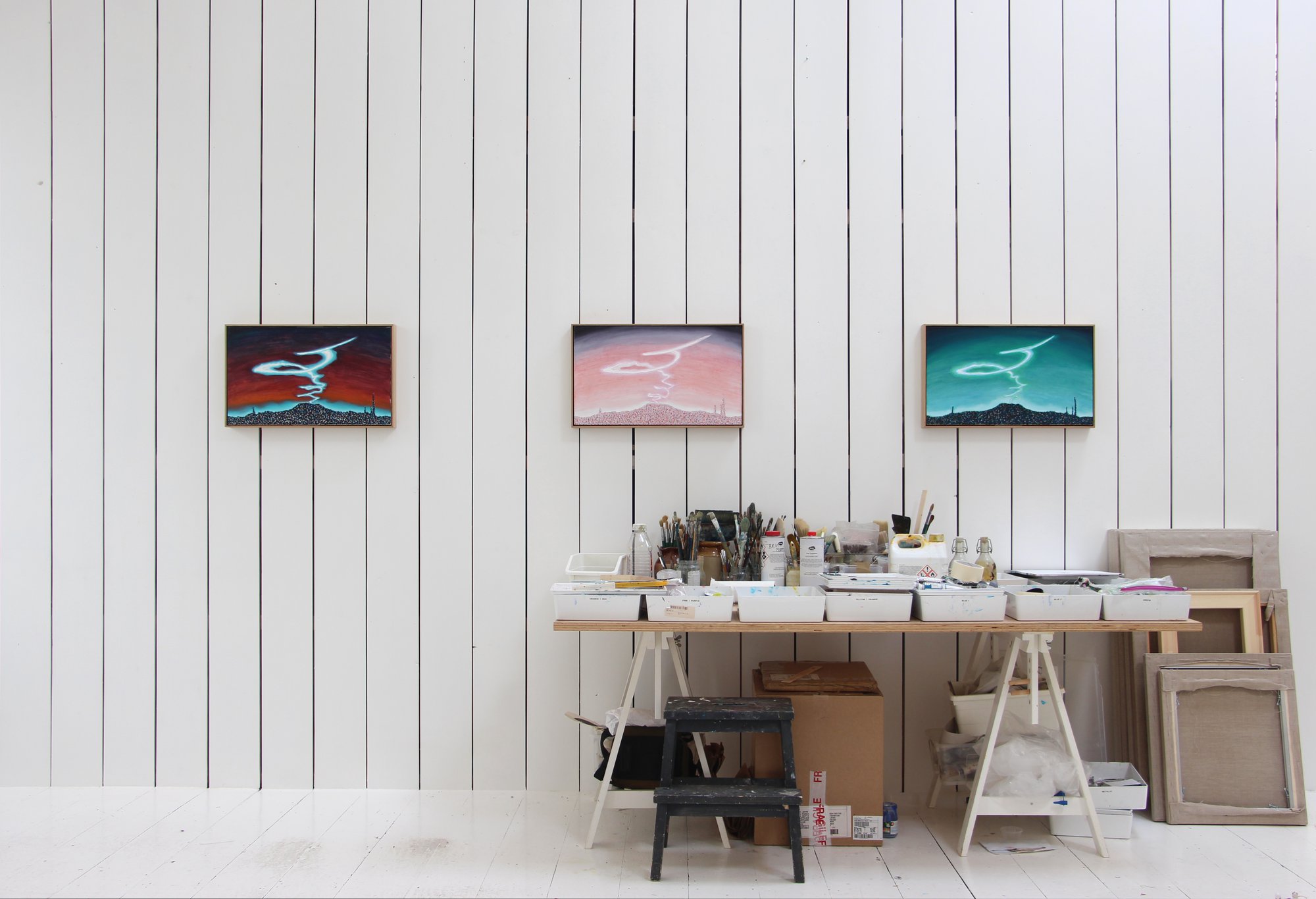
Photograph: Pace Gallery website
A thread of white light rises from a vibrantly colored hilltop. Like furled cigarette smoke around fingers it circles skyward, looming ominously above the land. William Monk’s new series of paintings, Untitled (zip) (2020), returns repeatedly to a single image: a mysterious and hovering vapor trail. It is set against vivid, luminescent skies of solar-flare orange, mildew green, and cotton-candy pink, crowning a series of unknown yet identical landscapes. Is it a redemptive symbol or a coded warning?
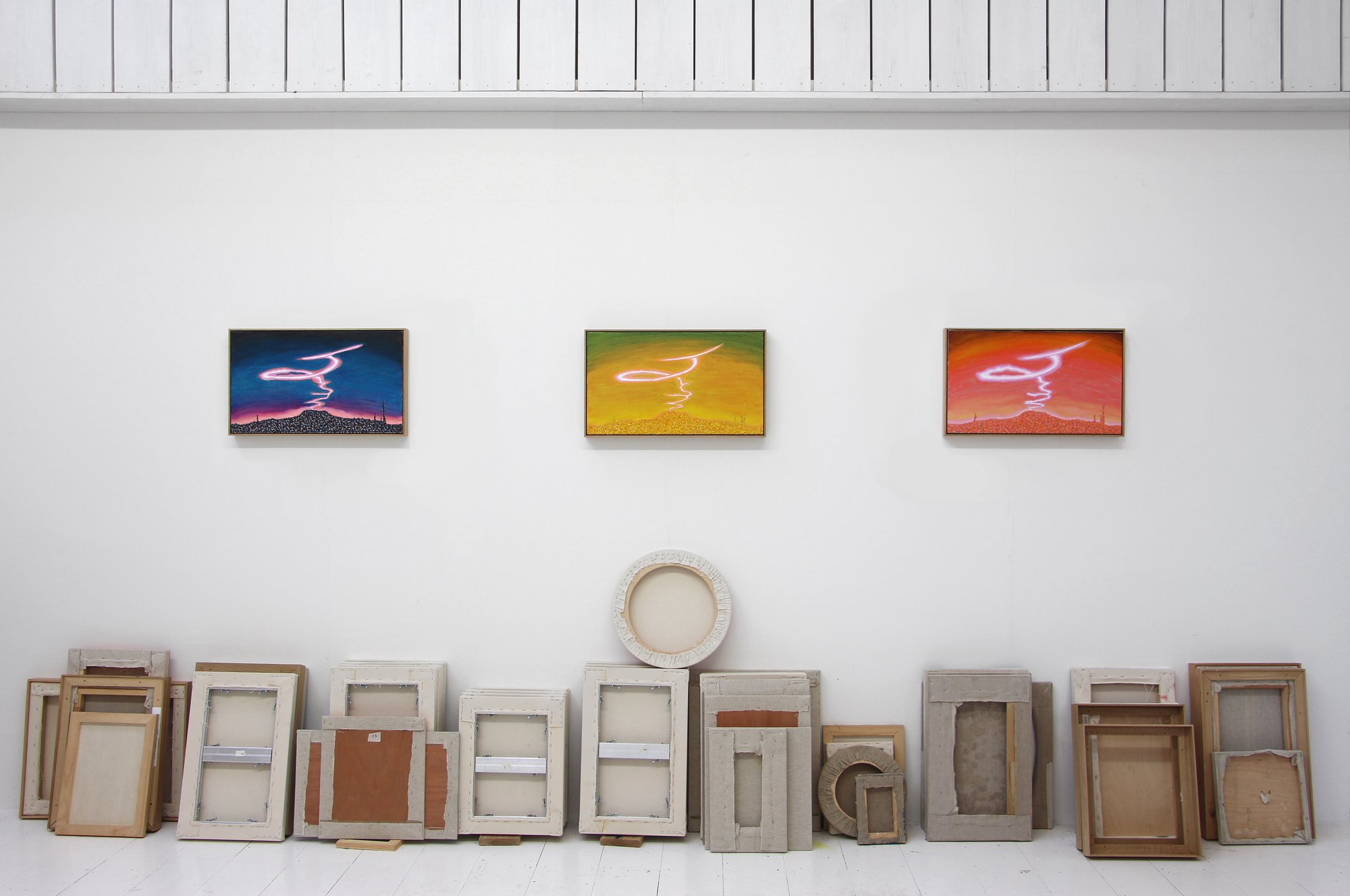
Photograph: Pace Gallery website
Monk refers to Pompeii, to volcanic spill, and to the thick cloud of ash that descended to cast people as three-dimensional shadows, caught in eternal darkness. His six “hill-tops” let loose not lava, but an unidentifiable and cryptic symbol that variously reminds one of a sequence from a sci-fi movie or the trail of a ground-to-air-missile. The cinematic and photographic memory looms large in Monk’s imagination—his grandfather, John Eldridge, was an influential British film director in the 1940s and ’50s, who pioneered documentary film-making and the editorial stylings of key directors such as David Lean, notably in Lean’s seminal bio-pic Lawrence of Arabia (1962). Monk suggests a photograph of a forest fire in France, the fuel trail of a missile, or the filmic sources that so obsessed the artist at a young age: A Clockwork Orange (1971), Stanley Kubrick’s teen-gang dystopic future vision or Antonioni’s revolutionary ‘60s hippie movie Zabriskie Point (1970), and Ridley Scott’s bleak future vision of tech-landscapes and artificial intelligence in Bladerunner (1982).
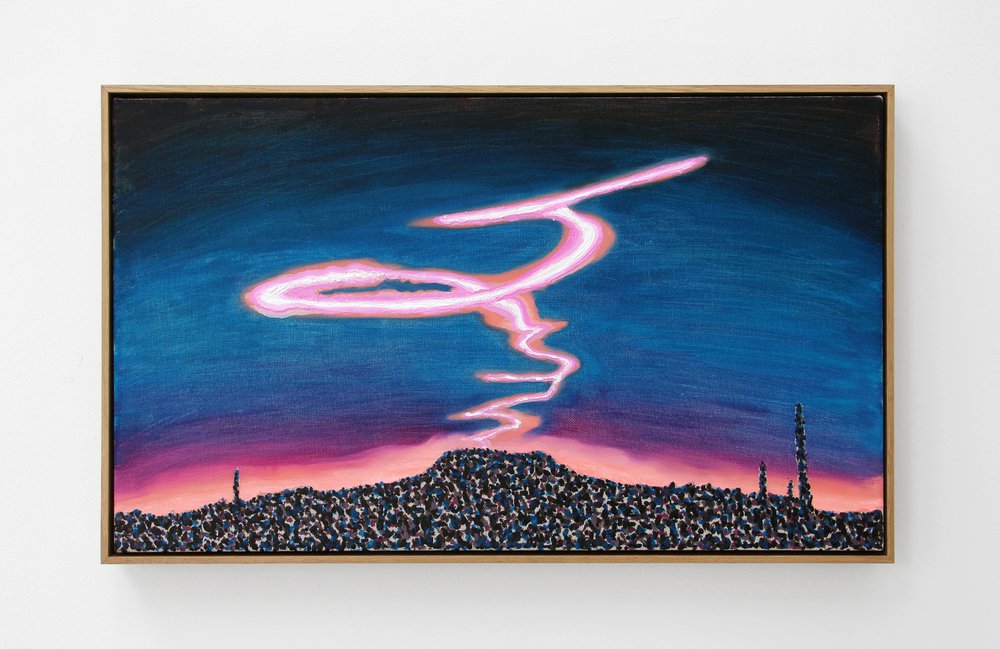
Photograph: Pace Gallery website
Even given the referents, Monk’s paintings exist without fixed meaning. As he states, “I don’t start from a position of knowing, and I don’t always end up there either.” Instead, we are witness to a visual mantra, a repeated sign and image that builds import through its seriality: canvas by canvas, two through seven. The meaning of the shape is unknown; is it malevolent, a warning, or simply an atmospheric anomaly?

Photograph: Pace Gallery website
Monk looks to found images and the filmmakers of a bygone era, if not for source imagery than for source meditation. Those indelible images were left by Kubrick of future teen gangs lost in the urban landscape and state control, or Godard’s trail of motor vehicle destruction in Weekend, or as in Zabriskie Point, Antonioni’s take on alienated isolation with its explosive denouement and abstract vision of slow-motion destruction sound-tracked by psych music pioneers Pink Floyd. The latter film’s tagline also feels pertinent to Monk’s process with its enlightened circularity and assertion: “How you get there depends on where you’re at!”
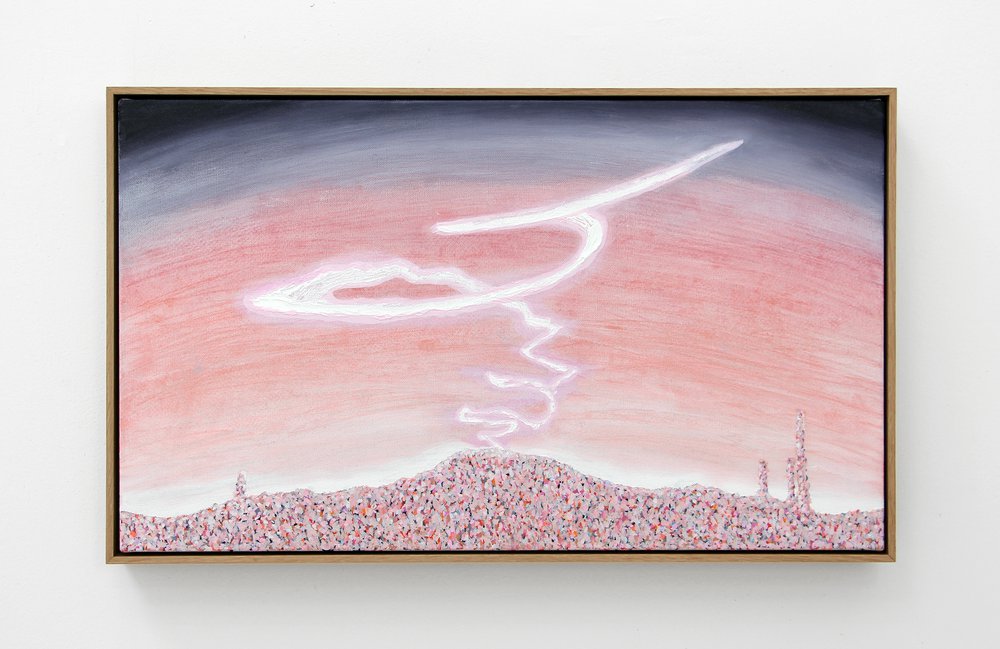
Photograph: Pace Gallery website
How does one shake off or come to terms with these images? Like the scribbled notes in the thrift-store novel or student textbook, Monk engages such subcultural marginalia. In doing so, he creates contemporary images that reposition the “out there” of the counter-cultural past, with the ideological fall-out of the now, only this time in paint. The writer Anthony Burgess created his own teenage cant or gang-speak in the novel A Clockwork Orange (1962). Based on Cyrillic script, the gang (the Droogs) invented their own way of communicating. As with many private languages, it dictated who belonged to the tribe and also introduced a peculiar argot and blunt poetry to the resultant Kubrick movie. The Droog’s “to slosh” was to hear or overhear, to listen in, and to define meaning in the language or music of others. In Alex’s case, it’s the terrifying images he conjures from his listening to Beethoven’s 9th Symphony (1822) that reveal his particular psychosis and predilection toward the violent. For Monk, his image, his “sloshing,” his listening and observation of the world, is searching for some new vision and form recalled from a personal dream-state or the hypnagogic mode of cinema to produce, as Alex the chief Droog would archly have it, “such lovely pictures!”

Photograph: Pace Gallery website
Now onto the last of Monk’s referents for Untitled (zip) and perhaps the one that most intrigues. In Spielberg’s Close Encounters of the Third Kind we follow Roy, played by Richard Dreyfuss, as he desperately attempts to find meaning in his obsessive need to carve or sculpt the image of a mountain—one that we later find will be the landing place and meeting point for alien and human life. His first attempt is through a pile of mashed potatoes over a weeknight dinner with his perturbed, to the point of fearful, family, and later he covers his living room in an outsized clay version of said mountain. Roy doesn’t fully understand, but he recognizes to the point of seeming out of control, that this image means something, something “important!” What greater suggestion of the artist at work than this scene in middle America? Spielberg’s suburban-alien-drama cannily depicts the desire née driven-need to create.
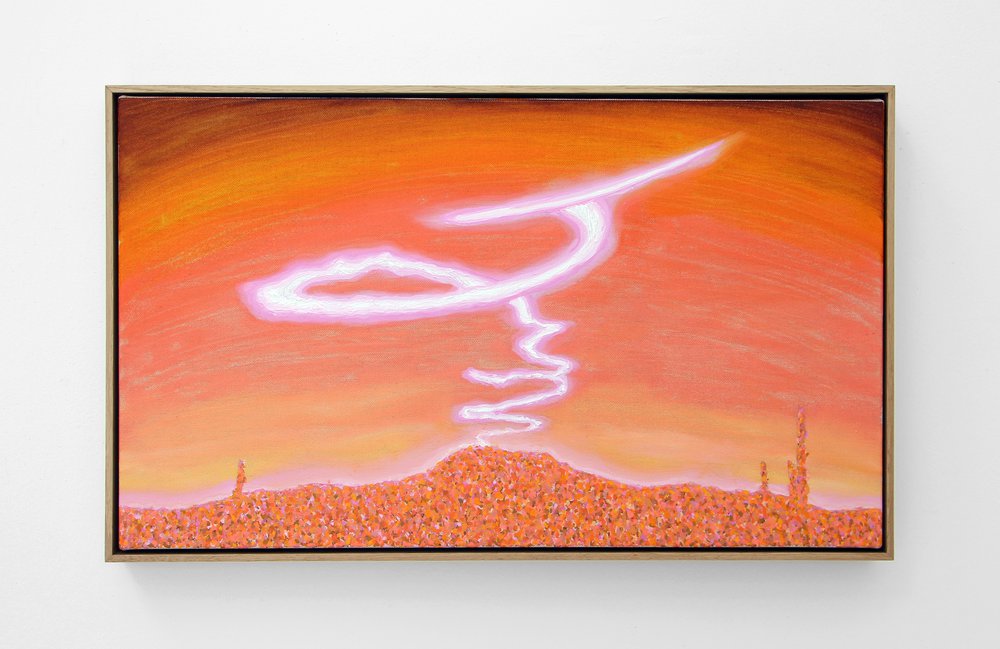
Photograph: Pace Gallery website
How many times have we heard the suggestion that a novelist, musician, or visual artist is trying to perfect their one narrative, their essential suggestion to the world? We hear it of J.G. Ballard’s endless reflection on cold humanity and surviving it, in Yoko Ono’s search for revelatory sonic dissonance and peace within, and in Giorgio Morandi’s lifetime commitment to capturing the soul and very essence of those beautifully rendered domestic vessels in paint. If it’s not too simple a suggestion, it is perhaps Monk’s seriality—his commitment to the almost totemic object-hood and ritual of paint and image and the search—that finds meaning. In the study of key shapes and forms, Monk defines a particular urban and painterly psychedelia that seeks to transcend, translate, and mirror an equivalence or weight of images found elsewhere: in a Kubrick, Antonioni, or Godard film.

Photograph: Pace Gallery website
As we find ourselves in lockdown, amid “The Great Pause,” we too are in search of meaning. In isolation with family members and loved ones, in the city or in suburbia, we wonder: what does it all mean? Creating new form from the collusion of painting and the cinematic imaginary, Monk asks us in our disquiet to consider the moment, raising a brush and paint to capture in his words this “silenced and beautiful apocalypse.”
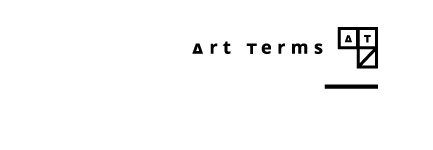
| Prev | [NEWS] Frieze Viewing Room Presents Artworks Selected for Frieze New York 2020 |
|---|---|
| Next | [SHOWS] COMPLEX SOCIETY @ SODA_Space of Design and Architecture, Hwaseong |
| List |